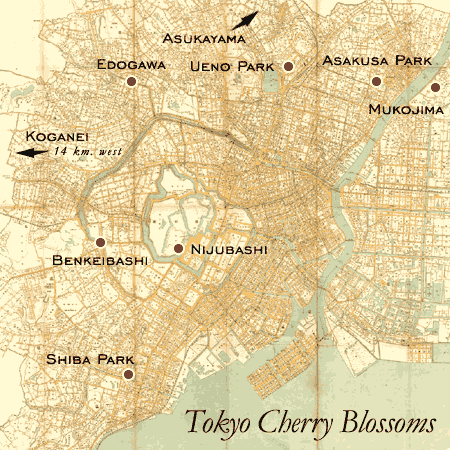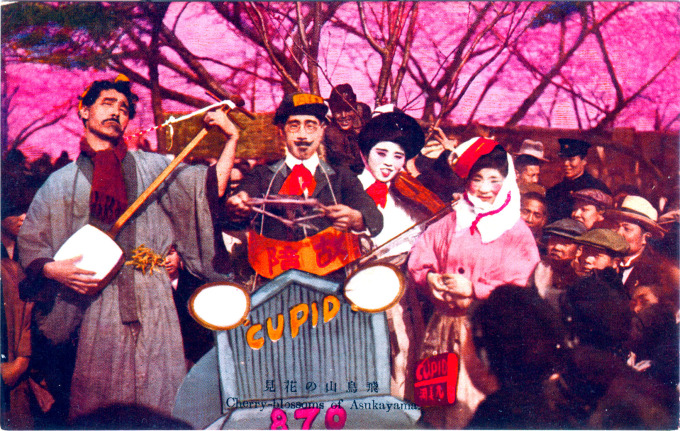“Brilliant is the career of the cherry-bloom, glorious is the life it pursues. But more brilliant and more glorious is the end it faces.
“For the bloom tarries not till its beauty fades, its fame departs. It lingers not on the branch till its stalk is rotten.
“… [T]he blossom of the sakura falls, leaving behind it a sweet fragrant air and a radiant reminiscence.
“The cherry thrives for a brief time ; but its fame survives.”
– “The Cherry Blossoms”, by Yae-kichi Yabe. The Tourist, March 1922

O-hanami gathering of a chindonya troupe (foreground) beneath the cherry blossoms at Asukayama, Tokyo, c. 1910. Chindonya were elaborately-costumed street musicians and touts who advertised for shops, restaurants, and other establishments, seen here taking a break from the rigors of street performances by celebrating the season’s hanami picnic-style under the blossoms.
See also:
“Advertisement on street”, c. 1920.
O-hanami (Cherry Blossoms Viewing).
“One thing that Japanese people repeat all the time is that Japan is unique because it has four distinct seasons.
“The implication is that no other place on earth does! This isn’t quite true of course, but I do think that the Japanese culture has a deep appreciation for the changes of the seasons. One of these appreciative rituals is o-hanami.
“Groups of people congregate on mats under the most picturesque clumps of cherry blossom trees with bento lunches and have a good old party. A lot of sake is usually involved.
“Since certain places in Tokyo are so popular for o-hanami gatherings, it is traditionally the job of the lowliest grunt in the office to go out early in the morning to the place where his bosses want to party later on that evening with a mat and stake out a choice spot under the trees. He’d then have to sit there all day.”
– Of Cherry Blossoms, O-hanami and Japanese Culture, by Maki
“Despite its name being a simple combination of 花 (hana, flower) and 見 (mi), from the verb 見る(miru, to view), if you’ve spent any time in Japan during spring, you’ll know that 花見 isn’t as simple as looking up into the trees.
“Sure, there is some flower viewing at a 花見, but there may also be a ピクニック (pikunikku, picnic) with food and drink. It may serve as a work function meant to build camaraderie or a reunion with old friends.”
– “We invite you to get ready for this year’s cherry blossom parties”, by Cassandra Lord, The Japan Times, March 15, 2024



